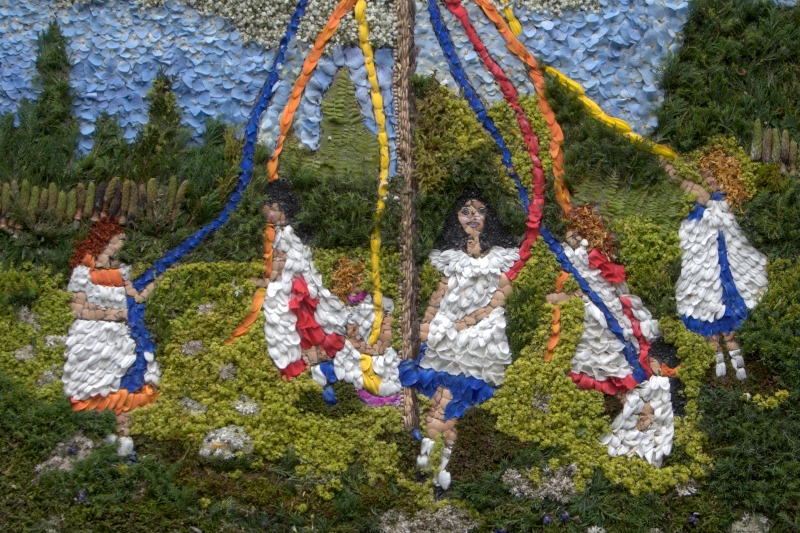
This is a story spelled out in petals, surrounded by moss and pressed into damp clay…
‘In the North Country, where I come from,’ said the Pilgrim Woman, ‘ I have wandered amongst remote hilly country with many moors and sheep – and few people.’
A warm salty breeze came in through the open door. It made the spangles on her skirts tinkle. The people inside the old chapel fanned themselves and even the Lord-by-the-Sea had taken off his fine jacket.
‘On such a hot day, I bring you a cooling story from those beloved peaks.’
There was a widow with seven daughters. The youngest was a strange, wayward child. She neither spoke nor sang, but danced to music only heard in her own heart.
It was in the days before girls were sent to school, and the widow, having six other lasses and a farm to look after, paid her youngest little mind. So it was that she ran free upon the tops.
All her running and dancing and laughing among the harebells would make her thirsty. There was one spring in particular she would go to. It bubbled out of a stone chamber beside a lone thorn tree; clear and cold and sweet to drink.
Every time the seventh daughter went to the ings, she left some token to give thanks: a bracelet of daisies, a garden fashioned from moss and lichen, a posy of ling and grouse feathers , tied with honeysuckle. Over time, these offerings became works-of-art. She made pictures from hazelnut shells and river pebbles, may blossom and ferns.
Then came a fierce and cloudless summer. Heat fell upon the heights, not rain. It baked the stones into cooking slabs and roasted the grass away. One by one the village wells dried up. Queues to fetch water grew, and more and more the widow and the other six daughters grumbled.
The seventh daughter came down from her well on a broiling afternoon, her skirts damp from kneeling and making art.
‘Where have you been?’ her sisters asked. ‘Where have you found water? Come – show us at once!’
The seventh daughter shook her head. The well was her secret, her hideaway from a village where stones whistled her way, where boys tried to grab her and where folk reckoned no words meant no mind.
But the weary, troubled faces of her sisters wore down the walls around her heart. She knew how little the grass grew and how the sheep suffered.
So she scraped an apronful of mud from the remains of the farm beck. Then she beckoned her sisters and they followed. They wondered as she plucked moss from the north sides of the trees they passed, and picked buttercups and sorrel heads from the meadows.
She led them to the well nearest their farmstead.It stood in the shade of three willow trees.
‘What ever is she doing?’ they asked each other.’Our lass is surely mazed – there’s never any water left in there!’
They watched as she knelt down and patted the mud she’d hefted into a heart shape. She edged it with willow leaves and and made borders with the flower heads. It was beautiful to watch and soon, despite themselves, the other daughters joined in. They were that busy creating patterns and pictures all around the dusty bowl of the spring, they didn’t hear their mother approach.
‘Praise be!’ she cried and fell to her knees beside the hand-made heart. She held out her two palms and scooped up a drink. The spring was flowing again.
The family laughed and skipped and hugged each other. All except the youngest. She lifted up her clay heart and took it to the neighbours’ well. There she showed them how to make their water flow again.
And in time, it became the custom to dress the wells among the high hills with flowers and clay in thanksgiving. And it still is.
picture courtesy of Chris Smith – close-up of Hayfield well-dressing, Derbyshire
